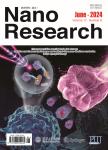Tuning the structures of two-dimensional cuprous oxid econfined on Au(111)
Tuning the structures of two-dimensional cuprous oxide confined on Au(111)作者机构:State Key Laboratory of Catalysis Collaborative Innovation Center of Chemistry for Energy Materials Dafian Institute of Chemical Physics Chinese Academy of Sciences Zhongshan Road 457 Dalian 116023 China Key Laboratory of Materials Modification by Laser Ion and Electron Beams Dalian University of Technology Ministry of EducationDalian 116024 China Department of Physics Applied Physics and Astronomy Rensselaer Polytechnic Institute Troy NY 12180 USA University of Chinese Academy of Sdences Beijing 100049 China
出 版 物:《Nano Research》 (纳米研究(英文版))
年 卷 期:2018年第11卷第11期
页 面:5957-5967页
核心收录:
学科分类:07[理学]
基 金:This work was financially supported by the Ministry of Science and Technology of China (Nos. 2017YFB0602205 and 2016YFA0202803) the Strategic Priority Research Program of the Chinese Academy of Sciences (No. XDB17020200) the National Natural Science Foundation of China (Nos. 21473191 91545204 11574040 and 11504040) the Thousand Talents Program for Young Scientists and the Supercomputing Center of Dalian University of Technology
主 题:cuprous oxide Au(111) scanning tunneling microscopy confine
摘 要:Two-dimensional (2D) cuprous oxide (Cu2O) nanostructures (NSs) of monolayer thickness were synthesized on Au(111) and characterized using atomic-resolution scanning tunneling microscopy, X-ray photoelectron spectroscopy, and density functional theory (DFT) calculations. The surface and edge structures of 2D Cu2O were resolved at the atomic level and found to exhibit a graphene-like lattice structure. Cu2O NSs grew preferentially at the face centered cubic (fcc) domains of Au(111). Depending on the annealing temperature, the shapes and structures of Cu2O NSs were found to vary from elongated islands with a defective hexagonal lattice (mostly topological 5-7 defects) to triangular NSs with an almost-perfect hexagonal lattice. The edge structures of Cu2O NSs also varied with the annealing temperature, from predominantly the arm-chair 56 structure at 400 K to almost exclusively the zig-zag structure at 600 K. DFT calculations suggested that the herringbone ridges of Au(111) confined the growth and structure of Cu2O NSs on Au(111). As such, the arm-chair edges of Cu2O NSs, which are less stable than the zig-zag edges, could be exposed preferentially at 400 K. Cu2O NSs developed into the thermodynamically-favored triangular form and exposed zig-zag edges at 600 K, when the Au(111) substrate became mobile. The confined growth of 2D cuprous oxide on Au(111) demonstrated the importance of metal-oxide interactions in tuning the structures of supported 2D oxide NSs.



